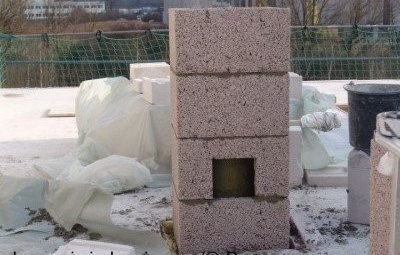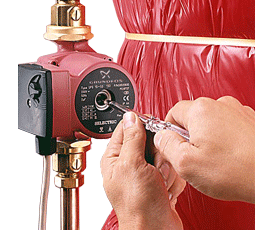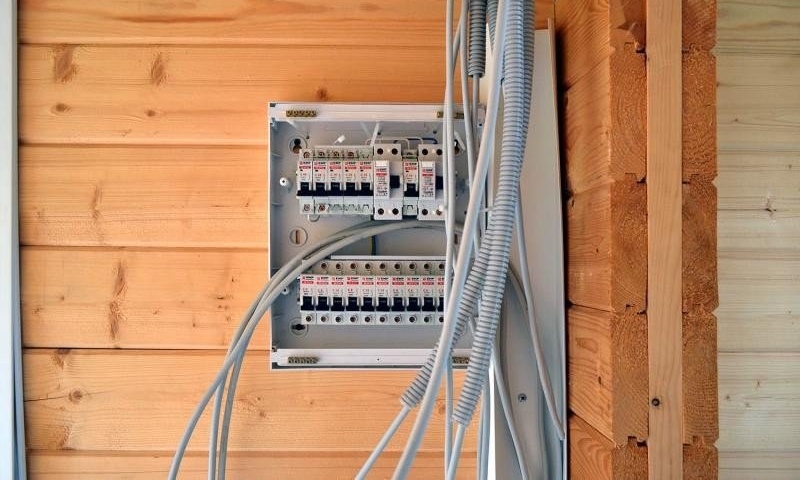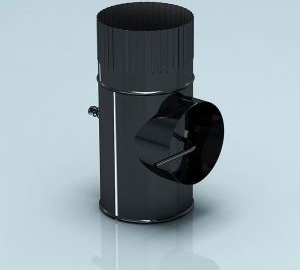What is a good ceramic chimney + analysis of the basic rules for its installation
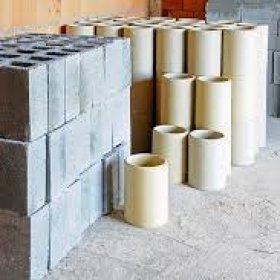
Useful properties of ceramic surfaces are finding new and non-standard applications. A layer of burnt clay is covered with kitchen utensils, heating elements of household appliances, knives, etc. So, a novelty has appeared in the construction industry - a ceramic chimney, which is increasingly being replaced by brick and steel structures.
Such a chimney consists of three layers. The inner layer is a ceramic pipe, which is assembled from individual elements having a circular cross section. The outer layer is hollow expanded clay concrete blocks of square section. The space between the outer layer and the inner part of the chimney is filled with a third component - a refractory heat insulator, usually basalt.
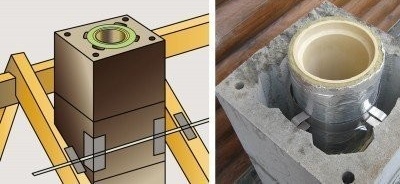
A ceramic chimney consists of three main layers: an internal ceramic pipe, basalt insulation and lightweight concrete outdoor units with a square section
To strengthen the structure, special holes are made in the outdoor units, into which fittings are installed during installation. This type of chimney can be mounted both inside the building and outside.
Please note: in multi-story construction, ceramic chimneys are not used, they are suitable only for private houses and cottages.
The ceramic chimney kit includes three groups of elements:
- a base consisting of a chimney, a condensate tank and two tees;
- main set;
- final set.
Content
Why is a ceramic chimney better / worse than other pipes?
The interest that ceramic chimneys for furnaces arouse in developers is understandable. Here are some of the advantages that distinguish them from steel and brick chimneys:
- the possibility of using all types of fuel;
- solid terms of operation;
- excellent heat storage ability;
- quick heating of the chimney;
- excellent traction;
- highest resistance to various types of corrosion;
- very high fire safety, etc.
Thanks to the ceramic chimney, combustion products are removed very efficiently, and heating costs are reduced due to high-quality thermal insulation. Chimney of this type is not afraid of precipitation, it does not form smudges, it is very easy to maintain. Ventilation is carried out using the supply air grille, which is mounted below. The base also has a special tank in which the condensate formed is discharged.
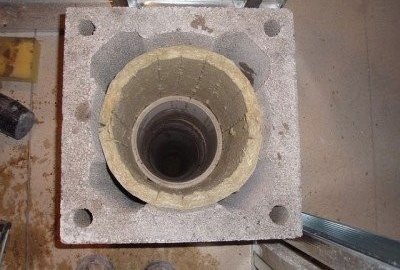
The outer layer of a ceramic chimney, as a rule, is made of hollow expanded clay concrete blocks, which have special openings for mounting fittings
Nothing is perfect in the world, this also applies to ceramic chimneys.Here are the main disadvantages of ceramic pipes that should be considered when deciding on the type of chimney for your home:
- relatively high price;
- complex installation, requiring mandatory professional skills;
- the smoke channel must be strictly vertical, bends are not allowed;
- significant physical weight of the structure.
Due to the high load on the base for ceramic chimneys, it is usually required to create your own foundation, which is not connected with the foundation of the house. The exception is cases when the structure is built on a very solid monolithic foundation, but in this case, careful engineering calculations of the bearing capacity of the foundation will be required. The same calculations will be needed if the chimney is not mounted on the foundation, but on the ceiling between floors.
The basic principles of installing such a chimney
The terms of operation and the quality of the removal of combustion products from the stove or fireplace largely depends on the correct installation of the ceramic chimney. Each manufacturer of these expensive designs provides the device with detailed instructions that should be carefully studied. Novice builders will also benefit from the help and advice of experienced craftsmen to avoid common mistakes during installation.
First you need to take care of the necessary materials. You will need fittings whose dimensions correspond to the diameter of the mounting holes in the outdoor units. Two rods should freely enter each groove so that there is still room for solution. In addition, for sealing you will need a special astringent that tolerates the effects of high temperature. Of course, you should stock up on a certain amount of sand and cement.
In general, the installation procedure of a ceramic chimney looks like this:
- Cut the reinforcement into pieces about 1.5 m in size.
- Pour the foundation under the chimney.
- Cover the foundation with roofing material to ensure its waterproofing.
- Install the foundation block.
- Perform waterproofing work between this unit and the pipe.
- Install a condensate collection tank.
- Attach the stove liner.
- Increase the required number of outdoor units.
- Insert the reinforcement into the holes and fill it with concrete using a funnel.
- Install the adapter and the door kit.
- Place the chimney insert and the insulating ring.
- Install a chamotte chimney liner on top of which a special heat-insulating material is applied.
- In places where the structure passes through the floors, it is necessary to install external thermal insulation.
- To decorate the chimney, then put a cover, an expansion cuff and a smoke umbrella.
Of course, this is only a general scheme. During the installation of the ceramic chimney, special attention must be paid to the correct installation of the fittings. The edges of the rods should overlap by about 10 cm.

To strengthen the outdoor blocks from expanded clay concrete, reinforcement rods are inserted into special holes and then they are poured with concrete mortar
An alternative option to strengthen the structure is external reinforcement, which is performed using a metal mesh and a corner. But this method is considered more laborious.
The installation process of the chimney is presented in the video material:
Some useful tips from experts
Experienced builders recommend when paying attention to a number of points when installing a ceramic chimney:
- Carefully check the integrity of each ceramic element. If a crack is found, do not try to repair it with sealant or other binding agent. These measures are effective only for a short time, and in order to eliminate the defect later, expensive dismantling of the entire chimney will be required.
- The joints of the chimney must not be under the ceiling so that they can be inspected.
- It must be ensured that the first block is correctly installed in a horizontal plane and fits snugly against the base. For this, a suitable material is laid on the foundation, such as porcelain tile, etc.
- In the course of work, the exact vertical position of the structure should be constantly checked.
- The connection point to the boiler should be decided in advance, since changing the height of the work or the connection angle is very difficult and not always possible.
- First, insulation is mounted, and then ceramic elements are installed.
- Before applying sealant to the ceramic chimney block, the surface should be thoroughly cleaned. Excess sealant is immediately removed.
- To avoid unnecessary costs, the installation of the chimney is carried out before the start of finishing work indoors, as well as before the end of roofing.
When installing a ceramic chimney in a wooden structure, the inevitable shrinkage of the building should be taken into account.
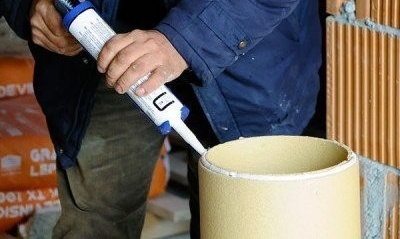
Before applying sealant to the surface of the ceramic block of the chimney, it must be cleaned of possible contaminants. Excess sealant is immediately removed.
All work should be carried out carefully, constantly monitoring the correctness of their implementation. If the technology is followed exactly and the right materials are selected, the chimney with a ceramic pipe will serve for several decades faithfully.
